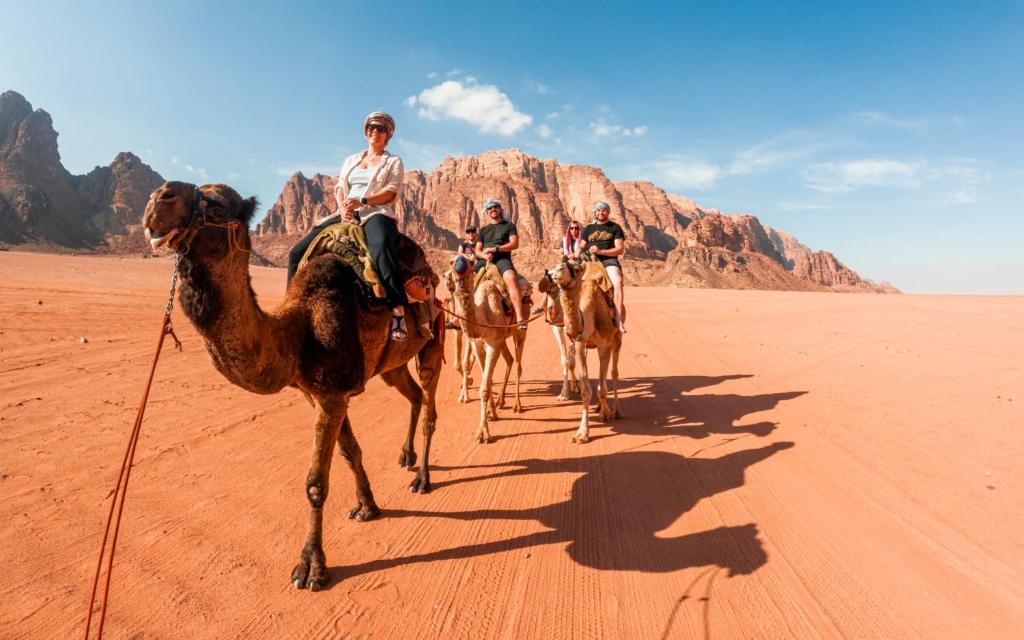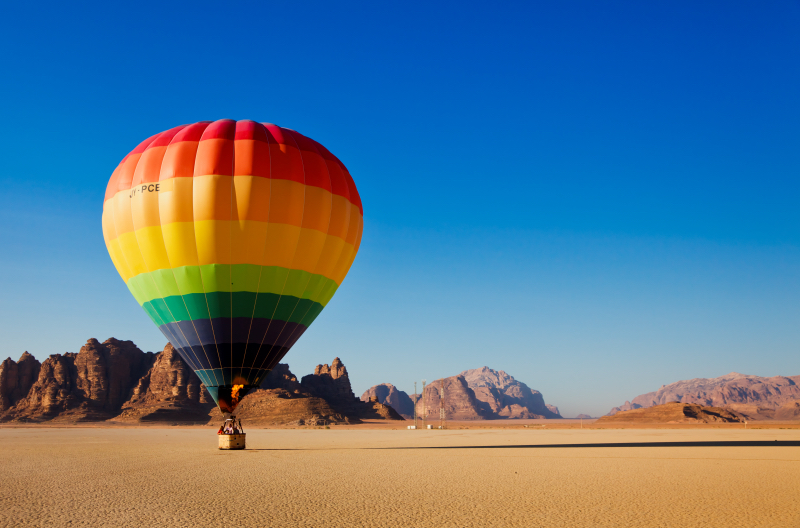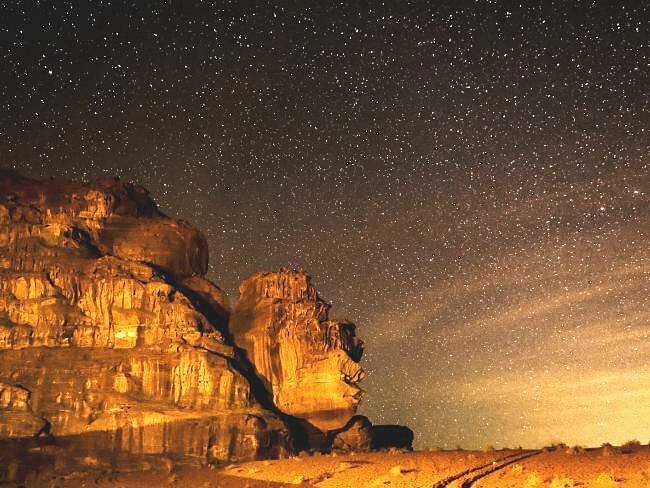Wadi Rum: Jordan's Best Kept Secret

Why this desert should be at the top of your travel list.
When travelers plan a trip to Jordan, Petra typically tops their must-visit list—and rightfully so. The ancient rose-red city carved into sandstone cliffs is undeniably spectacular. But just a short drive south lies a destination that, despite growing recognition, still feels like a magnificent secret: Wadi Rum. This vast desert wilderness offers experiences that rival (and some would argue surpass) even Petra's splendor, yet many visitors allocate just a half-day or single night to explore it. Those who know better understand that Wadi Rum deserves much more—it's Jordan's best-kept secret hiding in plain sight.
Beyond the Day Trip: Why Wadi Rum Deserves Your Time
Wadi Rum is often treated as a brief stopover between Petra and Aqaba or a quick add-on to a Jordan itinerary. Many tourists experience it as a rushed jeep tour followed by a single night in a desert camp. While even this limited exposure leaves visitors impressed, it barely scratches the surface of what this extraordinary place offers.
A Landscape Like No Other
Wadi Rum's unique geology sets it apart from other desert landscapes worldwide. The combination of massive sandstone mountains rising dramatically from flat sand valleys creates a scenery so otherworldly that filmmakers regularly use it as a stand-in for alien planets. Unlike the rolling dunes of the Sahara or the stark rock formations of the American Southwest, Wadi Rum presents a perfect balance of sculptural mountains and sweeping sands.
What many visitors don't realize until they arrive is the sheer scale of Wadi Rum. At over 720 square kilometers, the protected area contains countless hidden canyons, rock bridges, ancient inscriptions, and scenic viewpoints that can't possibly be experienced in a single day. Each valley has its own character, each mountain its own distinctive shape and color palette.
The Transformative Desert Experience
Those who spend multiple days in Wadi Rum often describe the experience as transformative. The desert has a way of recalibrating your senses and perceptions. The first day, you're simply taking in the visual spectacle. By the second day, you begin to notice subtler things—the different textures of sand, the surprising variety of desert plants, the changing quality of light throughout the day.
By the third day, many visitors report a profound shift in their relationship with time and space. The desert's vastness and the absence of modern distractions create a rare opportunity for presence and reflection that's increasingly valuable in our hyperconnected world. This deeper experience simply isn't possible on a brief visit.
Hidden Treasures: What Most Visitors Miss
Standard day tours of Wadi Rum follow established routes to the most accessible attractions. While these highlights are certainly worth seeing, they represent only a fraction of what the desert has to offer. Here are some of the hidden treasures that most visitors never experience:
Remote Canyons and Valleys
Beyond the popular sites lie secluded canyons and valleys that few tourists ever see. These remote areas offer a sense of discovery and solitude that's increasingly rare in popular destinations. Places like the colorful Colored Canyon with its rainbow-hued sandstone, the narrow passages of Al Mahama Canyon, or the hidden valley of Um Sabatah require more time to reach but reward visitors with pristine desert landscapes and often complete privacy.
Lesser-Known Rock Bridges
While Burdah Rock Bridge and Um Fruth Rock Bridge feature on standard tours, Wadi Rum contains numerous other natural arches and bridges that remain relatively unknown. These include the delicate Khor al Ajram Bridge, the perfectly framed Little Bridge, and the challenging but rewarding Rainbow Rock Bridge. Each offers unique perspectives and photographic opportunities for those willing to venture beyond the standard routes.
Ancient Petroglyphs and Inscriptions
Wadi Rum's human history stretches back thousands of years, evidenced by the numerous petroglyphs and inscriptions scattered throughout the desert. While guides show some well-known examples on standard tours, the most impressive collections often require dedicated trips to more remote locations. These include the extensive Alameleh inscriptions, the detailed hunting scenes at Jebel Umm Ishrin, and the mysterious star maps carved into rocks in the northern reaches of the protected area.
Desert Ecosystems and Wildlife
Despite its harsh appearance, Wadi Rum supports surprising biodiversity. Visitors who spend more time in the desert have opportunities to observe rare desert plants, especially after seasonal rains, and might glimpse some of the area's elusive wildlife. Desert specialists like the Sinai agama lizard with its brilliant blue breeding colors, the graceful sand gazelle, or the desert lark with its melodious song reveal themselves to patient observers who linger in the desert.
The Cultural Dimension: Beyond the Landscape
Wadi Rum isn't just a natural wonder—it's also home to Bedouin communities with a rich cultural heritage that extends back countless generations. Brief visits rarely allow for meaningful cultural exchange, but longer stays open doors to authentic experiences and deeper understanding.
Bedouin Knowledge and Traditions
The Bedouin of Wadi Rum possess extraordinary knowledge about desert survival, traditional medicine, navigation by stars, and sustainable living in one of Earth's most challenging environments. This wisdom, accumulated over centuries and passed down through generations, represents an invaluable cultural heritage. Visitors who spend more time with Bedouin guides have opportunities to learn about these traditions—from tracking animals by their footprints to identifying medicinal desert plants or reading the night sky as a natural map.
Traditional Music and Storytelling
Evening gatherings around the campfire often feature traditional Bedouin music played on instruments like the rababa (a single-stringed violin) and the shababa (a type of flute). These sessions sometimes evolve into storytelling, with tales of desert adventures, tribal histories, and ancient legends. While tourist camps often provide abbreviated versions of these cultural experiences, more authentic and extensive sessions typically occur during longer stays or in less commercialized settings.
Traditional Crafts and Skills
From weaving goat-hair tents to crafting leather goods and traditional jewelry, Bedouin craftsmanship reflects generations of practical knowledge and artistic expression. Some camps and local families offer workshops where visitors can learn about these traditional skills—experiences that require more time than a standard overnight stay allows.
The Secret Seasons: When to Really Experience Wadi Rum
Another aspect of Wadi Rum that remains relatively unknown to most visitors is how dramatically the desert changes with the seasons. Each time of year reveals a different face of the desert, offering unique experiences beyond the standard visit.
Winter Wonders (December-February)
Winter in Wadi Rum brings cool days perfect for hiking and climbing, followed by cold nights that showcase exceptionally clear starry skies. The low-angle winter sunlight creates dramatic shadows and highlights the texture of the rock formations. Occasional rain showers bring temporary streams and waterfalls to the desert, transforming the landscape in ways few visitors ever witness. The relative lack of tourists during this season means more authentic experiences and often lower prices.
Spring Blooms (March-May)
After winter rains, Wadi Rum can experience a brief but spectacular flowering period when the desert floor erupts with colorful wildflowers. This ephemeral display typically peaks in March or April, depending on rainfall patterns. The contrast between vibrant flowers and red sand creates photographic opportunities that summer visitors would never imagine possible in this seemingly harsh environment.
Autumn Clarity (September-November)
As summer heat subsides, autumn brings comfortable temperatures and exceptional visibility. The air quality during this season is often at its best, allowing for unparalleled views of distant mountains and photographic conditions that showcase the desert's rich colors. The angle of light creates a golden glow during morning and evening hours that photographers particularly prize.
Beyond the Standard Tour: Alternative Ways to Experience Wadi Rum
Most visitors experience Wadi Rum through a standard jeep tour followed by an overnight stay in a desert camp. While this provides a taste of what the desert offers, alternative approaches reveal Wadi Rum's secrets in more profound ways.
Multi-Day Trekking
For active travelers, multi-day hiking routes through Wadi Rum offer an immersive desert experience that day-trippers never encounter. These journeys, typically supported by camels carrying equipment and supplies, follow ancient Bedouin paths between water sources and sheltered camping spots. Trekking routes can be tailored to different fitness levels, from moderate walks between scenic points to challenging summit-to-summit adventures for experienced hikers.
The rhythm of desert trekking—walking in the cool morning hours, resting during midday heat, and continuing in the late afternoon—connects travelers to traditional patterns of desert movement. Nights spent camping in different locations throughout the protected area reveal the diversity of Wadi Rum's landscapes and allow access to remote areas rarely seen by other visitors.
Camel Caravans
Following the tradition of desert travelers for thousands of years, multi-day camel treks offer a distinctive perspective on Wadi Rum. The elevated vantage point from camelback provides different views of the landscape, while the slower pace allows for deeper observation and reflection. The gentle swaying motion and rhythmic footfalls of camels create a meditative quality to the journey that many travelers find profoundly calming.
These journeys typically include instruction in basic camel handling, insights into the centuries-old relationship between Bedouins and their camels, and evenings spent at traditional-style camps in different locations throughout the desert. The experience connects travelers to an ancient mode of desert travel that shaped trade routes and cultural exchanges throughout the region's history.
Specialized Interest Journeys
For visitors with specific interests, Wadi Rum offers specialized experiences that reveal particular aspects of the desert in depth:
- Photography journeys: Guided by experts who know the best locations for different times of day and seasons, these trips focus on capturing Wadi Rum's visual splendor through professional photography techniques
- Geology expeditions: Led by knowledgeable guides who explain the fascinating geological processes that created Wadi Rum's distinctive landscape over millions of years
- Astronomy-focused stays: Centered around the extraordinary stargazing opportunities in Wadi Rum, with telescope observations and guidance in astrophotography
- Rock climbing adventures: For experienced climbers, multi-day trips focusing on Wadi Rum's world-class traditional climbing routes on sandstone towers and walls
- Cultural immersion: Extended stays with Bedouin families that offer deeper insights into traditional desert lifeways, from bread making to herbal medicine
The Sustainable Secret: Responsible Tourism in Wadi Rum
Perhaps the most important "secret" about Wadi Rum is the critical importance of sustainable tourism practices in preserving this fragile ecosystem and cultural landscape. As visitor numbers increase, the challenge of balancing tourism development with environmental and cultural preservation becomes increasingly urgent.
Environmental Considerations
Despite its rugged appearance, Wadi Rum's ecosystem is surprisingly fragile. Desert plants grow extremely slowly and can take decades to recover from damage. The desert surface often has a biological crust that prevents erosion but is easily damaged by vehicles and foot traffic. Water sources are precious and limited.
Visitors who understand these realities can make choices that minimize their impact—selecting tour operators who follow established tracks, properly disposing of all waste, conserving water, and respecting wildlife. Longer, more immersive stays often have less environmental impact per day than rushed tours that attempt to see everything quickly.
Cultural Sustainability
The Bedouin communities of Wadi Rum face the challenge of maintaining their cultural identity while adapting to the opportunities and pressures of tourism. Visitors can support cultural sustainability by choosing locally-owned camps and tour operations, respecting cultural norms regarding photography and appropriate dress, and expressing genuine interest in Bedouin traditions beyond superficial demonstrations.
Longer stays typically create more meaningful cultural exchanges and direct more tourism revenue to local communities through additional services and experiences beyond the basic tour package.
How to Discover the Secret for Yourself
If you're inspired to experience Wadi Rum beyond the standard visit, here are practical suggestions for planning a more immersive journey:
Allocate Sufficient Time
The single most important factor in experiencing Wadi Rum's secrets is time. While one night gives you a taste, consider allocating at least two or three nights to truly begin appreciating the desert's depth. Those seeking a transformative experience might stay four or five nights, perhaps in different locations throughout the protected area.
Choose the Right Partners
Research tour operators and camps that specialize in more in-depth experiences rather than standard packages. Look for:
- Locally-owned operations with deep roots in the area
- Companies that emphasize environmental sustainability
- Guides with specialized knowledge relevant to your interests
- Operations that offer customized itineraries rather than fixed routes
- Camps in diverse or more remote locations within the protected area
Consider Shoulder Seasons
Visit during spring (March-May) or autumn (September-November) for ideal weather conditions and fewer tourists. Winter (December-February) offers a completely different desert experience with the possibility of seeing rare rain effects and enjoying exceptionally clear night skies.
Come with an Open Mind
The most profound experiences in Wadi Rum often come from unexpected moments—a sudden change in light, a quiet conversation with a Bedouin guide, or the absolute silence of the desert at dawn. Approach your visit with curiosity and openness rather than a rigid checklist of sights to see.
Disconnect to Reconnect
Embrace the limited connectivity in Wadi Rum as an opportunity rather than an inconvenience. The absence of constant digital stimulation allows for a deeper connection with the landscape, your traveling companions, and your own thoughts.
The Ultimate Secret: A Personal Relationship with the Desert
Perhaps the greatest secret of Wadi Rum is that it offers something increasingly rare in our standardized, digitized world—the opportunity to develop a personal relationship with a place of extraordinary natural power. Unlike experiences that can be fully captured in photographs or adequately described in words, Wadi Rum affects visitors on a level that's difficult to articulate but profoundly felt.
Those who give themselves the gift of time in this remarkable landscape often find that Wadi Rum becomes more than just a destination visited—it becomes a touchstone experience that they carry with them long after leaving the desert behind. The vastness of the landscape, the quality of the silence, the brilliance of the stars, and the timeless wisdom of Bedouin culture combine to create an experience that many describe as life-changing.
This deeper connection is the true best-kept secret of Wadi Rum—not any particular location or activity, but the profound impact that this extraordinary place can have when experienced fully and mindfully. In a world of increasingly packaged and commodified travel experiences, Wadi Rum offers something authentic, powerful, and deeply personal to those willing to look beyond the standard tour and discover its secrets for themselves.

